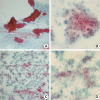Diagnostic difficulties in fine needle aspiration of benign salivary glandular lesions
- PMID: 23323108
- PMCID: PMC3540335
- DOI: 10.4132/KoreanJPathol.2012.46.6.569
Diagnostic difficulties in fine needle aspiration of benign salivary glandular lesions
Abstract
Background: The diagnostic accuracy of fine needle aspiration cytology (FNAC) of salivary lesions is relatively high, but cytologic interpretation might be confusing if the sample is lacking typical cytologic features.
Methods: There were 77 cases of benign salivary lesions, consisting of pleomorphic adenoma (PA) in 61 cases, Warthin's tumor (WT) in 12 cases, and other benign lesions in 4 cases. The causes of the discrepancies between the FNAC and the histologic diagnoses were evaluated.
Results: Major discrepancies were noted in 4 of the 61 PA cases, and in 1 of 12 WT cases. The causes of the major discrepancies were a mislabeled site in 1 PA and 1 WT case, and an interpretation error in 3 PA cases. Minor discrepancies were more common in the WT cases (7 of 12 cases) than in the PA cases (11 of 61 cases). The causes of the minor discrepancies were a mislabeled site in 1 PA and 1 WT case, an inadequate sample in 7 PA and 2 WT cases, a lack of typical cytomorphology in 2 PA and 2 WT cases, and an interpretation error in 1 PA and 2 WT cases.
Conclusions: To increase the diagnostic accuracy in the benign salivary lesions, recognition of both characteristic and less typical cytomorphology is needed.
Keywords: Benign lesion; Biopsy, fine-needle; Salivary glands.
Conflict of interest statement
No potential conflict of interest relevant to this article was reported.
Figures



Similar articles
-
[Fine-needle aspiration cytology of tumors of major salivary glands].Nihon Jibiinkoka Gakkai Kaiho. 1998 Oct;101(10):1283-91. doi: 10.3950/jibiinkoka.101.10_1283. Nihon Jibiinkoka Gakkai Kaiho. 1998. PMID: 9838797 Japanese.
-
Role of fine needle aspiration cytology in the diagnosis of swellings in the salivary gland regions: a study of 712 cases.Med Princ Pract. 2004 Mar-Apr;13(2):95-106. doi: 10.1159/000075637. Med Princ Pract. 2004. PMID: 14755143
-
Assessing the diagnostic accuracy for pleomorphic adenoma and Warthin tumor by employing the Milan System for Reporting Salivary Gland Cytopathology: An international, multi-institutional study.Cancer Cytopathol. 2021 Jan;129(1):43-52. doi: 10.1002/cncy.22339. Epub 2020 Aug 7. Cancer Cytopathol. 2021. PMID: 32767837
-
Cytopathology and diagnostics of Warthin's tumour.Cytopathology. 2020 May;31(3):193-207. doi: 10.1111/cyt.12830. Cytopathology. 2020. PMID: 32259367 Review.
-
Comparison of ultrasound-guided core biopsy versus fine-needle aspiration biopsy in the evaluation of salivary gland lesions.Head Neck. 2013 Nov;35(11):1657-61. doi: 10.1002/hed.23193. Epub 2012 Oct 29. Head Neck. 2013. PMID: 23109044 Review.
Cited by
-
Different MRI-based radiomics models for differentiating misdiagnosed or ambiguous pleomorphic adenoma and Warthin tumor of the parotid gland: a multicenter study.Front Oncol. 2024 Jun 13;14:1392343. doi: 10.3389/fonc.2024.1392343. eCollection 2024. Front Oncol. 2024. PMID: 38939335 Free PMC article.
-
Salivary gland tumors: a diagnostic dilemma!J Maxillofac Oral Surg. 2015 Mar;14(Suppl 1):438-42. doi: 10.1007/s12663-014-0665-1. Epub 2014 Jul 15. J Maxillofac Oral Surg. 2015. PMID: 25848154 Free PMC article.
-
Salivary gland lesions: diagnostic reliability and challenges of fine needle aspiration cytology.Int J Clin Exp Pathol. 2021 Jan 1;14(1):54-62. eCollection 2021. Int J Clin Exp Pathol. 2021. PMID: 33532023 Free PMC article.
-
Diagnostic Accuracy of Fine Needle Aspiration Cytology (FNAC) in Salivary Gland Lesions with Histopathological Examination (HPE) Correlation in a Tertiary Care Centre in Southern India.Indian J Otolaryngol Head Neck Surg. 2023 Jun;75(2):871-879. doi: 10.1007/s12070-023-03550-6. Epub 2023 Feb 10. Indian J Otolaryngol Head Neck Surg. 2023. PMID: 37275112 Free PMC article.
-
Improving the diagnosis of common parotid tumors via the combination of CT image biomarkers and clinical parameters.BMC Med Imaging. 2020 Apr 15;20(1):38. doi: 10.1186/s12880-020-00442-x. BMC Med Imaging. 2020. PMID: 32293304 Free PMC article.
References
-
- Kechagias N, Ntomouchtsis A, Valeri R, et al. Fine-needle aspiration cytology of salivary gland tumours: a 10-year retrospective analysis. Oral Maxillofac Surg. 2012;16:35–40. - PubMed
-
- Layfield LJ, Gopez EV. Cystic lesions of the salivary glands: cytologic features in fine-needle aspiration biopsies. Diagn Cytopathol. 2002;27:197–204. - PubMed
-
- Paik I, Lee HK, Lee YD. The role of fine needle aspiration cytology of salivary gland tumors. J Korean Surg Soc. 1999;57:533–540.
-
- Zhang S, Bao R, Bagby J, Abreo F. Fine needle aspiration of salivary glands: 5-year experience from a single academic center. Acta Cytol. 2009;53:375–382. - PubMed
-
- Singh Nanda KD, Mehta A, Nanda J. Fine-needle aspiration cytology: a reliable tool in the diagnosis of salivary gland lesions. J Oral Pathol Med. 2012;41:106–112. - PubMed
LinkOut - more resources
Full Text Sources

